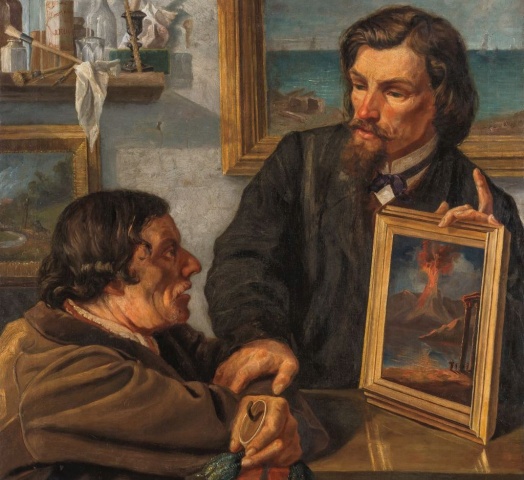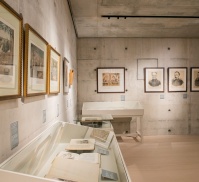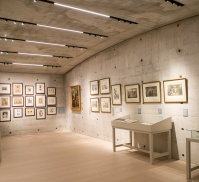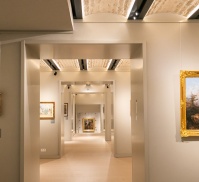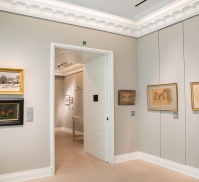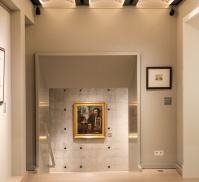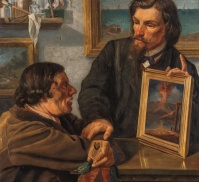The Age of Romanticism
The collection of Lithuanian Art Centre TARTLE features numerous works of Lithuanian fine arts of the 19th century. The 2nd exhibition invites visitors to learn more about the 19th century through art history. This period is first and foremost linked to Romanticism, efforts to preserve historical memories, cherishing of traditions, accentuation of resistance as well as the cult of national heroes and spiritual leaders. On the other hand, romantic approach of the 19th century towards cultural life and artistic language conveys not only history, but also myths. Based on those aspects, the exposition seeks to disclose the spirit of the Romantic era as well as take a different look at what seems well-known. The exhibition includes the works of painters, graphic artists and sculptors of Lithuania of the 19th century along with some works of foreign painters focused on the Lithuanian motifs. Visitors will find the works of less-known authors together with those of such celebrities as Franciszek Smuglewicz, Józef Oleszkiewicz, Edward Mateusz Römer, Albert Żamett, Michał Elwiro Andriolli, Kazimierz Alchimowicz, Wincenty Slendziński, Józef Bałzukiewicz, Mark Antokolsky andFerdynand Ruszczyc.
The exhibition reflects various fields of fine arts of Romanticism; however, particular attention is given to graphic arts and book illustrations because these fields best demonstrate typical features of the age of Romanticism, such as inextricable link between art and literature, close cooperation of painters and graphic artists, dissemination of artistic works through the press and subscription, which resulted in fine arts becoming relatively “cheaper” and more prevalent in various strata of society.
Specific features of the Romanticism worldview are revealed by employing certain themes. Thus the ground floor is dedicated to different aspects of Romanticism in art. History, fiction and fine arts of the 19th century turned their focus on Lithuania’s past. Interest in the past gave birth to a phenomenon which was especially characteristic to Lithuania in the 19th century – a passion for archaeology and accumulation of ancient monuments. The start of the exposition tells us about mythologization of history and aspiration to bring the heritage of the pagan Lithuania up-to-date, so typical of the Romanticism worldview. One of the spaces of the exhibition is designated to the typical painter of the 19th century of local origin and a description of his noblemen’s environment. Special attention is paid to Adam Mickiewicz, one of the brightest personalities of Lithuania’s and Poland’s culture in the 19th century; the plots of his works became an inexhaustible source for the fine arts of Romanticism.
Painters of Romanticism were looking for inspiring examples and heroic figures corresponding to the picture of a hero of the era. This is the focus of the story told in the rooms of the lower floor dedicated to heroes of resistance, such as legendary Tadeusz Kościuszko, a hero of Napoleon’s wars prince Józef Poniatowski, or peasants who defended Kražių church at the end of the 19th century. Another important source of inspiration for Romanticism painters was landscape. Landscape was understood as an important part of ethnic identity; it was believed to determine the character of people living in that land leading to the expression of the nation’s spirit. This topic is represented by paintings of Lithuanian artists, mostly landscapes, created abroad. The adjacent room houses paintings reflecting artists’ ambition to immortalize the originality of their homeland, convey its character as well as express its Catholic identity through religious plots and motifs. The Great Hall exhibits the most significant illustrated books of the 19th century, works created according to the motifs of literary works, authors’ portraits and illustrations of scientific works.
Rūta Janonienė
Art Historian, Curator of the Exhibition
Photos: Džoja Barysaitė

The collection of Lithuanian Art Centre TARTLE features numerous works of Lithuanian fine arts of the 19th century. The 2nd exhibition invites visitors to learn more about the 19th century through art history. This period is first and foremost linked to Romanticism, efforts to preserve historical memories, cherishing of traditions, accentuation of resistance as well as the cult of national heroes and spiritual leaders. On the other hand, romantic approach of the 19th century towards cultural life and artistic language conveys not only history, but also myths. Based on those aspects, the exposition seeks to disclose the spirit of the Romantic era as well as take a different look at what seems well-known. The exhibition includes the works of painters, graphic artists and sculptors of Lithuania of the 19th century along with some works of foreign painters focused on the Lithuanian motifs. Visitors will find the works of less-known authors together with those of such celebrities as Franciszek Smuglewicz, Józef Oleszkiewicz, Edward Mateusz Römer, Albert Żamett, Michał Elwiro Andriolli, Kazimierz Alchimowicz, Wincenty Slendziński, Józef Bałzukiewicz, Mark Antokolsky andFerdynand Ruszczyc.
The exhibition reflects various fields of fine arts of Romanticism; however, particular attention is given to graphic arts and book illustrations because these fields best demonstrate typical features of the age of Romanticism, such as inextricable link between art and literature, close cooperation of painters and graphic artists, dissemination of artistic works through the press and subscription, which resulted in fine arts becoming relatively “cheaper” and more prevalent in various strata of society.
Specific features of the Romanticism worldview are revealed by employing certain themes. Thus the ground floor is dedicated to different aspects of Romanticism in art. History, fiction and fine arts of the 19th century turned their focus on Lithuania’s past. Interest in the past gave birth to a phenomenon which was especially characteristic to Lithuania in the 19th century – a passion for archaeology and accumulation of ancient monuments. The start of the exposition tells us about mythologization of history and aspiration to bring the heritage of the pagan Lithuania up-to-date, so typical of the Romanticism worldview. One of the spaces of the exhibition is designated to the typical painter of the 19th century of local origin and a description of his noblemen’s environment. Special attention is paid to Adam Mickiewicz, one of the brightest personalities of Lithuania’s and Poland’s culture in the 19th century; the plots of his works became an inexhaustible source for the fine arts of Romanticism.
Painters of Romanticism were looking for inspiring examples and heroic figures corresponding to the picture of a hero of the era. This is the focus of the story told in the rooms of the lower floor dedicated to heroes of resistance, such as legendary Tadeusz Kościuszko, a hero of Napoleon’s wars prince Józef Poniatowski, or peasants who defended Kražių church at the end of the 19th century. Another important source of inspiration for Romanticism painters was landscape. Landscape was understood as an important part of ethnic identity; it was believed to determine the character of people living in that land leading to the expression of the nation’s spirit. This topic is represented by paintings of Lithuanian artists, mostly landscapes, created abroad. The adjacent room houses paintings reflecting artists’ ambition to immortalize the originality of their homeland, convey its character as well as express its Catholic identity through religious plots and motifs. The Great Hall exhibits the most significant illustrated books of the 19th century, works created according to the motifs of literary works, authors’ portraits and illustrations of scientific works.
Rūta Janonienė
Art Historian, Curator of the Exhibition
Photos: Džoja Barysaitė






